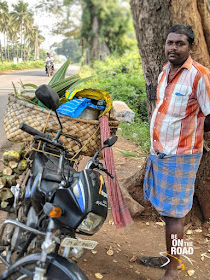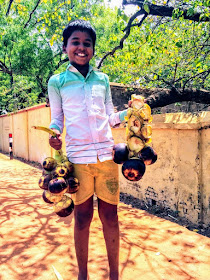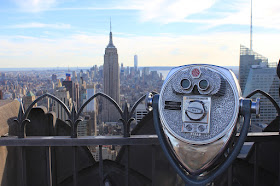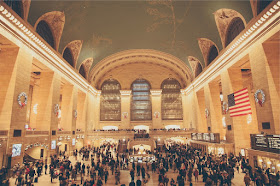
One of Incredible India’s iconic landmarks, the Amba Vilas Palace or the Mysore Palace, is the second most visited tourist attraction in India after the
Taj Mahal. It is estimated that more than 8 million people visit this palace every year, most of whom visit during the colorful and regal Dasara festival. There are 3 things that are noteworthy when it comes to the Mysore Palace. One, is the world famous Dasara festival with the decorated elephants and all the fanfare. Then, there is the night view of the Mysore Palace that is illuminated with over 97,000 bulbs on Sundays, national holidays and the during the 10 days of Dasara celebrations. The third and final highlight are the interiors of the palace that are an epitome of beauty, a rich dash of colors and a work of pure art.
Above photo: This is the private durbar hall inside the Mysore palace. Not only is it insanely beautiful, it also carries an air of opulence.

All these years, one could only take photographs from the outside and you had to apply for special permissions to photograph inside. However, the rules changed recently and everyone can photograph inside the beautiful Mysore Palace. This recent change can be seen outside the palace where many vendors can be seen selling selfie sticks to the visitors.
Above photo: This public durbar hall of Mysore palace is located on the 1st floor and is possibly the most photogenic room in the palace. This place is a huge hit with people who want to take selfies or get their profile photos clicked.

This is fabulous news for all those selfie lovers, budding photographers, architecture photographers, travel photographers and for all those people simply looking to create a good holiday memory. You can take photographs everywhere inside and outside the palace with the exception of the cordoned off areas. The only areas where you continue to need special permissions are if you wish to use the palace premises for a professional photoshoot, if you wish to use a tripod and/or if you wish to do professional videos.
Above photo: This room is one of the first large rooms you encounter during your exploration of the palace. Its ornate pillars and patterned flooring are breath-taking.

This article is more like a photo story of Mysore Palace. I simply wanted to capture different elements of its Indo-Saracenic architecture that contains beautiful blends of Hindu, Mughal, Rajput and Gothic styles. I hope these pictures make you want to visit this insanely gorgeous palace. The people of Bangalore are the most lucky due to their close proximity to Mysore. They can simply plan a easy day trip from Bangalore, which includes a visit to the Chamundeshwari temple in the morning followed by a traditional Mylari Dosa breakfast and then visits to the Mysore Palace, museums, Brindavan garden, shopping districts and other attractions before returning to Bangalore in the evening. For people from other states, they can easily base themselves in Mysore and enjoy its relaxed pace and lush green environment.
Above photo: These windows inside the Mysore palace are an element that is hardly noticed by the visitors as they head to other iconic rooms, but if you stare at it for a bit, you cannot stop admiring its beautiful architecture.

I would simply visit Mysore just to photograph the Mysore palace in its full glory. I still haven’t visited the palace during the Dasara festival, which I hear is an absolutely amazing experience, but I can certainly say that I have seen it stunningly lit from the outside and have photographed its colorful, opulent and aesthetic interiors. It is truly an amazing destination for photography!
Above photo: The Indo-Saracenic architecture can be seen most clearly from the outside of the palace due to the many red colored domes located on the top of the palace structure.

How to get there:
Mysore has an airport, though Bangalore would be your best option when it comes to best connectivity for domestic and international flights. The 3 hour drive from Bangalore to Mysore can be either made using cars or you can opt for the KSRTC buses from Bangalore airport to Mysore. Train connectivity between Bangalore and Mysore is excellent and many long distance trains make their way to Mysore. For last mile connectivity in Mysore, you can opt for auto rickshaws or horse carts.
Above photo: Every inch of the public durbar hall is a treat to the eyes. Its beauty makes me want to transport myself a 100 years back and be a part of an actual durbar session.

What are the palace timings:
The palace ticket counter opens at 10 AM, though it is best to head there at least 30 minutes before if you are heading there on a weekend or a national holiday. The palace closes at 5:30 PM, though if you are already inside, you can spend another hour or so.
Above photo: One of Mysore’s amazing holiday experiences is to go on a horse cart ride in the wee hours of the morning. Most of these rides start in front of the Mysore palace before making its way through the different cobbled pathways and roads of this beautiful city.

Mysore palace in the night:
There is a light and sound show in the night that you can experience and if you happen to be in Mysore on a Sunday or a national holiday, do wait till 8 PM to see the Mysore palace in all its illuminated glory.
Above photo: The chandeliers, lights and colored glass of this private durbar hall are truly eye popping.

Best season to visit Mysore:
Mysore is good to visit all year around, though the peak summer months can be a bit warm at times.
Above photo: The main entrance of the Mysore palace and a closer look at its lovely arches, pillars and domes.

Other best experiences to be had in Mysore:
1) Chamundeshwari temple for a powerful temple and amazing aerial views of Mysore city
2) St. Philomena Cathedral
3) Brindavan Gardens
4) Mysore Zoo, if you have young kids with you
5) Shop for Mysore silk sarees at the government silk weaving factory
6) Have a meal or a drink at the stunningly beautiful Lalith Mahal Palace hotel, a popular location for movie shoots
7) Have a Mylari Dosa breakfast at Original Vinayaka Mylari hotel
8) Explore Devaraja market during the early morning hours
Above photo: Mysore palace’s beauty lies in its various elements. These are wall tiles, which could have been influenced by Persia or even our own very Chettinad region.

Attractions worth visiting near Mysore:
1) The Somnathpur Chenna Keshava Temple
2) Kabini Tiger Reserve for a true jungle experience
3) Bandipur Tiger Reserve to get closer to the elephants
4) Namdroling Nyingmapa Monastery (Golden temple) at Bylaguppe
5) The historical town of Srirangapatna
6) The birding paradise of Rangaathittu
7) Barachukki and Gaganachukki waterfalls
8) The toy town of Channapatna
9) The subterranean temples at Talakad
Above photo: Likewise with the flooring. I absolutely love them and if available today, I would instantly fix them on the floors of my house.

Above photo: Mirrors kept at different corners of the public durbar hall add a bit of additional magic to this stunning room. These mirrors also allow you to play around when it comes to photography.

Above photo: The blue, gold and red colors of the private durbar hall are simply mesmerizing.

Above photo: This is one room where I could lie down and appreciate the beauty for hours together.

Above photo: While exploring the Mysore palace, always keep an eye open for all the traditional Hindu elements, vaastu, HIndu gods and mythological creatures. You will notice them in almost every room.

Above photo: A slightly different perspective of the public durbar hall Do you notice the image of goddess Chamundeshwari (Durga) in the far right?.

Above photo: The rich detailing on the pillars and the beautiful flooring are something to die for when it comes to creativity. I wish they didn’t use the strong tungsten lights here.

Above photo: A wide angle view of the public durbar hall, a pretty large room and which overlooks into the front of the palace.

Above photo: I loved the ancient blue looking fan that sits in the middle of this private durbar hall. It adds variety to this otherwise symmetrical room.

Above photo: A floor level view of the public durbar hall. I wish I could have lied down at this place and studied the carvings more closely.





























































